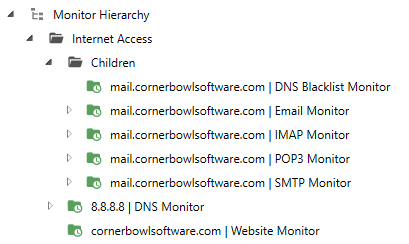Table of Contents
- Getting Started
- Agent-Based Monitoring
- Data Providers
- Directory Services
- Auditing
- Hosts
- Templates
- Template Properties
- Batch Update Templates
- Log Management Templates
- File and Directory Monitor Templates
- Windows Monitor Templates
- Account Lockout Monitor Template
- Logon Monitor Template
- CPU Monitor Template
- Memory Monitor Template
- Disk Space Monitor Template
- SMART Monitor Template
- Windows Update Template
- Process Monitor Template
- Service Monitor Template
- Performance Counter Monitor Template
- PowerShell Template
- Registry Value Monitor Template
- Active Directory User Monitor Template
- Active Directory User Integrity Monitor Template
- Task Scheduler Template
- Clock Synchronization Template
- Defragment NTFS Disks Template
- Network and Application Monitor Templates
- Database Monitor Template
- Directory Service Monitor Template
- DNS Blacklist Monitor Template
- DNS Monitor Template
- Domain Expiration Monitor Template
- Network Speed Monitor Template
- Ping Monitor Template
- Database Table Reseed
- SQL Server Shrink and Backup Template
- SSH Shell
- TCP Port Scan Monitor Template
- Website Monitor Template
- SSL Certificate Monitor Templates
- Email Monitor Templates
- SNMP Monitor Templates
- Monitors
- Reports
- Auto-Configurators
- Filters
- Actions
- Desktop Actions
- Email Actions
- Event Log Actions
- Executable Actions
- File Actions
- IIS IP Address Restriction Actions
- Microsoft Teams Actions
- PowerShell Actions
- Report Actions
- Service Actions
- SMS Actions
- SNMP Trap Actions
- Syslog Actions
- Template Actions
- IIS IP Address Restriction Actions
- Action Variables
- Schedules
- Environment Variables
- Options
- Account Lockout Monitoring and Reporting
- Merging Logs
- SNMP
- SSH Shell
- Syslog
- Exporting and Importing Configuration Objects
- Shared Views
- Auto-Config Host Assignment Properties
- General Executable Properties
- Assign Actions
- Assign Directories
- Assign Disks
- Assign Shares
- Assign Files
- Assign Consolidated Logs
- Assign Event Logs
- Assign Azure Audit Logs
- Target Files and Sub-Directories
- Define Log Entry Columns
- Define Log Entry Columns with Regular Expressions
- Define CSV and W3C Log Entry Columns
- Active Directory User and Group Filters
- Explicitly Assigned Logs
- File Explorer
- Report Columns
- Report Date/Time Ranges
- Report Security Event Log Filters
- Select Folder or File
- Executable Timeline
- Command Line Interface
- Troubleshooting
- Terminology
Monitor Hierarchy
Monitor Hierarchy enables the software to suppress error actions when another monitor has triggered. This functionality enables you to limit the number of error actions you receive when there is a major network failure such as an internet failure. For example, rather than receiving error notifications for all internet specific templates when your internet connection goes down, you can configure Monitor Hierarchy so you only receive either one or a limited number of error notifications when the internet goes down.
Example
In the example below, the configuration verifies both the Corner Bowl Software website and the Google DNS Server are responding. If both of these servers are unreachable, then when the monitors assigned to the Child Monitor Hierarchy Group error, the error actions will be suppressed. These rules can also be applied to the recovery actions, again enabling the software to suppress recovery actions when the internet connectivity is resolved so you only receive recovery notifications from the parent monitors and not the child monitors.

To configure the Monitor Hierarchy
- From the Explorer view, navigate to the Monitor Hierarchy node.
- Right-click and select New Group. Specify the name of the group then press Enter.
- Right-click on the newly created group then select Properties. The Monitor Hierarchy Group Properties view displays.
-
Use the Suppress child group monitor errors... option to suppress error
actions from monitors assigned to child Monitor Hierarchy Groups when
ALL parent monitors have errored, otherwise, child monitors will suppress
error actions when ANY parent monitor has errored.

Once a parent group is triggered as defined by this option, either ALL or ANY, a suppress recovery flag is set on all child monitors. -
Use the Suppress child group monitor recoveries... option to clear the
suppress recovery flag mentioned above on monitors assigned to child Monitor
Hierarchy Groups when ALL parent monitors have recovered and the
child monitor has not yet triggered, otherwise, each child monitor recovery
suppression flag will be cleared when ANY parent monitor recovers and the
child monitor has not yet errored.

When any child monitor recovers from an error state and the suppress recovery flag is cleared immediately after suppressing the recovery actions. - Next, create a new child group. There is no need to configure the child group unless you are going to add another child group under your newly created child group.
- Use Drag-Drop to assign monitors to both the parent and child groups.
To assign monitors to a Monitor Hierarchy Group
- From the Explorer view, navigate to the host then template you would like to assign.
- Use Drag-Drop to assign each monitor to the appropriate group.